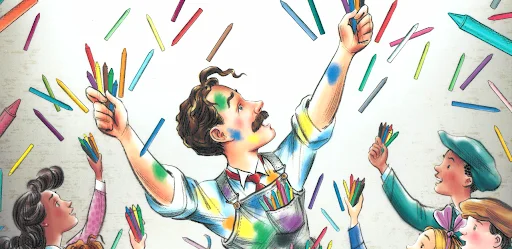Have you ever wondered if Crayola crayons are used by you in school time? These colorful, wax-based drawing instruments have been a staple in art classrooms and households for over a century. Wax crayons not only come in a variety of colors but their smooth texture and blending ability make them the perfect medium for reflecting your artist’s side.
But have you ever wondered about the history of these beloved crayons and the technology behind them? Here, we’ll discuss the fascinating story of Crayola crayons and the innovative techniques that make them a go-to for artists of all ages.
The Birth of Crayola
The story of Crayola begins in 1885 when Edwin Binney and C. Harold Smith started a company in Peekskill, New York. This company produced red oxide pigment used in barn paint. However, the partners soon shifted their focus to developing new pigments for commercial use. In 1900, they developed a new slate-colored pigment that was non-toxic and durable. The pigment was perfect for use in school chalkboards, and the company soon became a major supplier of chalkboard chalk.
The Invention of Crayola Crayons
In 1903, Binney & Smith took another leap forward in the development of art supplies with the invention of the first-ever crayon colors. Made by blending paraffin wax and pigments together resulting in a smooth, easy-to-use drawing tool. The box contained only eight colors of crayons: red, orange, yellow, green, blue, violet, brown, and black.
The Evolution of Crayola
Over the years, Crayola has expanded its product line to include a wide variety of art supplies, from colored pencils to markers. The company has also continued to innovate with its wax crayons, introducing new features such as twistable crayons, 4 pack crayons, bulk crayon packs, and washable crayons. Today, Crayola offers a huge range of crayon options, from classic packs of 8 to giant sets with over 150 colors.
How Wax Crayons Are Made
So, how exactly are Crayola wax crayons made? The process starts with blending paraffin wax and powdered pigments in a large mixing tank. The mixture is then heated to a temperature of around 250 degrees Fahrenheit. This will melt the wax and allows it to blend evenly with the pigments. The liquid wax is then poured into molds, which are cooled with water until the wax solidifies into a crayon shape. The crayons are then wrapped in their iconic paper labels and boxed for sale.
The Benefits of Using Wax Crayons
These crayons remain a popular choice for artists of all ages due to many reasons. Even for young children, wax crayons are incredibly easy to use. The smooth texture of the wax makes it easy to create bold, vibrant drawings, and the wide range of colors available ensures that there is a crayon for every project. These crayons are also ideal for use in schools and at home as they are non-toxic and washable.
Tips for Getting the Most out of Your Wax Crayons
If want to enhance or beautify your drawing to the next level! Here are some tips for getting the most satisfying results with your crayons. Try blending colors together to create new shades and hues. You can also use different drawing techniques like shading or cross-hatching to get impressive results. Opt for layering the colors on top of each other to create interesting effects.
Conclusion
Crayola crayons have a rich history and a bright future. From their humble beginnings as a simple slate-colored pigment, to the vibrant range of colors available today. Wax crayons are one of its most popular and versatile products due to excellent features such as smooth blending etc.
